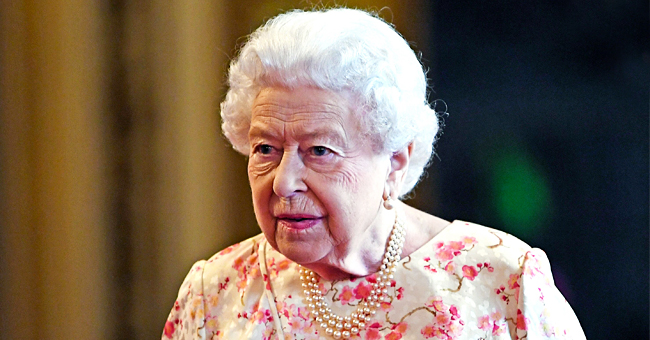
Queen Elizabeth's Two Birthdays & Other Royal Traditions That Might Seem Strange Explained
Navigating royal tradition and etiquette can be a daunting task, but it has a practical and universal side that avoids embarrassment, even though some of the traditions are wrapped up in peculiar bows.
TWO BIRTHDAYS FOR THE MONARCH
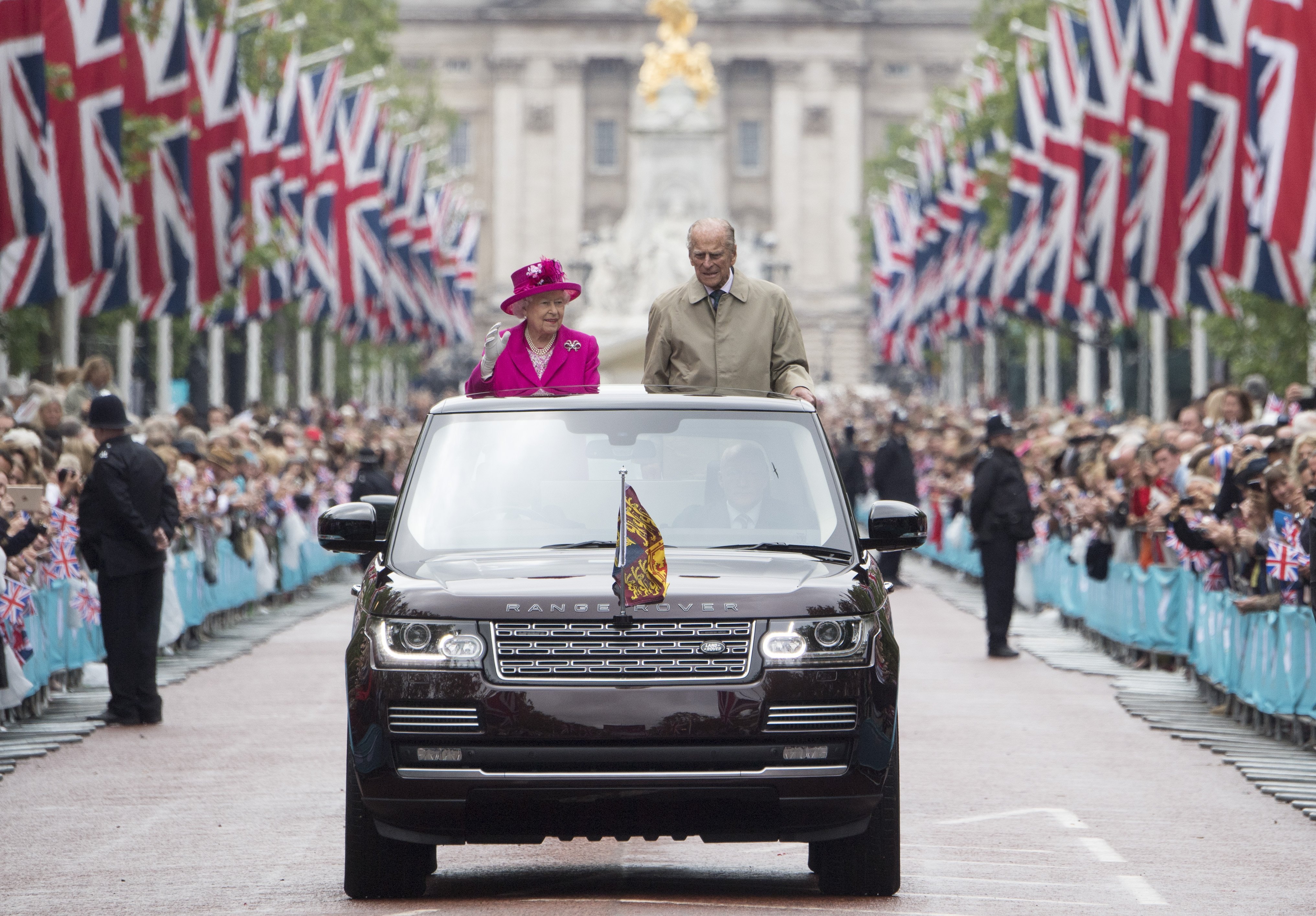
Queen Elizabeth II and Prince Philip, Duke of Edinburgh wave to guests attending "The Patron's Lunch" celebrations for The Queen's 90th birthday on The Mall on June 12, 2016, in London, England. | Source: Getty Images.
Queen Elizabeth gets to celebrate her birthday twice. Firstly she celebrates her actual birthday privately on April 21, followed by her "official" public celebration on a Saturday in June.
The Queen's public celebration happens in proper British royal tradition complete with a horse and carriage procession called Trooping the Colour.
Fourteen hundred uniformed guards accompanied by 400 musicians and 200 horses parade along the Mall in London. Afterward, the rest of the royal family join the Queen on Buckingham Palace's balcony where she addresses the crowds.
The reason for the two celebrations comes down to the weather, as summer presents the only suitable time for a proper parade.
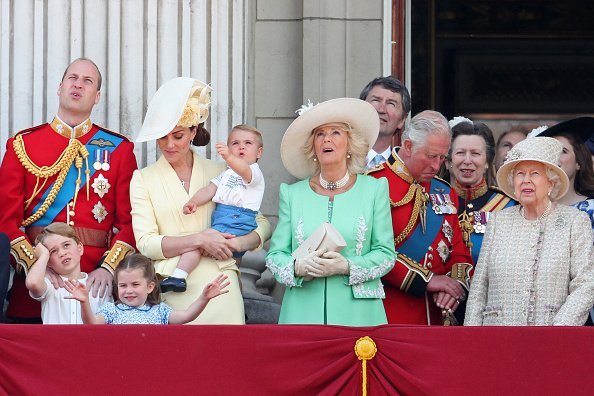
Prince Louis, Prince George, Prince William, Duke of Cambridge, Princess Charlotte, Catherine, Duchess of Cambridge, Camilla, Duchess of Cornwall, Prince Charles, Prince of Wales, Princess Anne, Princess Royal and Queen Elizabeth II during Trooping The Colour, the Queen's annual birthday parade, on June 08, 2019, in London, England. | Source: Getty Images.
King George II started the tradition in 1748, with his birthday in October, the King opted to combine his birthday celebrations with the annual summer military march. Since then, the reigning monarch has the choice of a summertime birthday celebration.
STATE OPENING OF PARLIAMENT
Even though the official yearly opening of Parliament in May is a straight forward occasion, it is marked by an elaborate ritual.
For starters, the Queen travels to the Palace of Westminster in her own carriage, separate from the regalia and Imperial State Crown. Heading straight to the Palace's "Robing Room," the Queen then gets dressed in a robe and crown before she leads a procession into the chamber of the House of Lords.
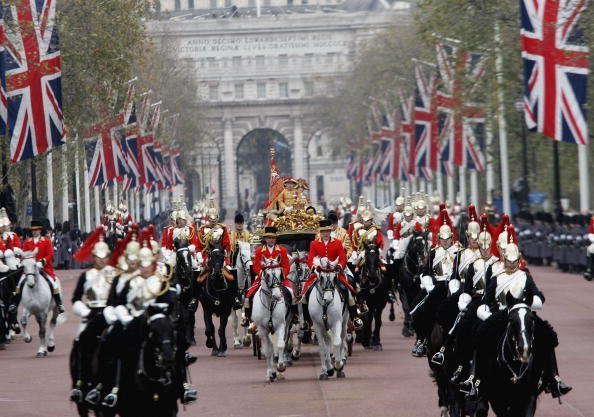
Queen Elizabeth II on route back to Buckingham Palace on November 23, 2004, in London, England. The Queen will today deliver her annual speech to the House of Commons at the State Opening of Parliament. | Source: Getty Images.
After delivering her speech to both Houses of Parliament, the new year of lawmaking can begin. However, the odd part of the ritual soon follows when the door of the House of Commons chamber is intentionally slammed in the face of a House of Lords official, known as "the Usher of the Black Rod." The purpose of the odd tradition represents the Commons independence from the monarchy.
CEREMONY OF THE KEYS
As one of the oldest military ceremonies in the world, the tradition of the keys takes place at the Tower of London every single day, as it has for the last 700 years. While the daily ritual originated as a security measure, it since became a matter of tradition.
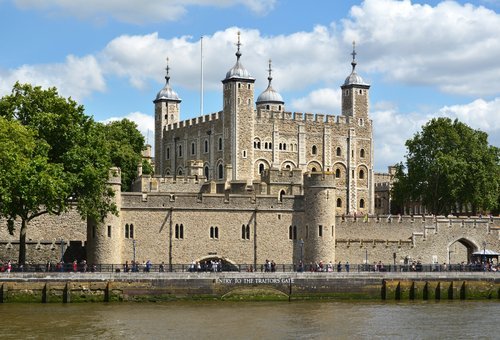
The Tower of London. | Source: Shutterstock.
At 9:53 pm every night, the Chief Yeoman Warder and an escort of the Queen's Guardsmen secures all the gates of the tower. When they get to the Bloody Tower, the sentry asks, "Who goes there?" When the Warder confirms to have the Queen's keys, the sentry lets him pass.
THE RAVEN GUARDIANS
One of the lesser-known traditions, the Tower of London always has no less than six raven guardians. Dating back to the 1600s, Charles II started the tradition after a royal astronomer complained that the ravens interfered with his work in the Tower of London.
When the King ordered the ravens be killed, a superstitious courtier advised told him that the Crown and Britain would fall if the ravens are lost or fly away.
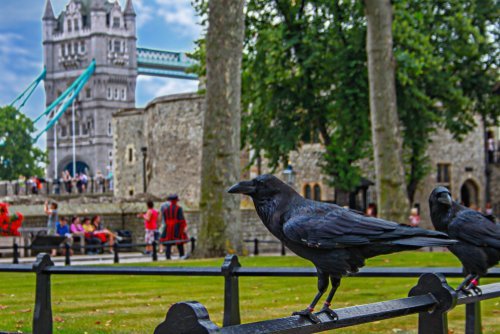
Ravens at the Tower of London. | Source: Shutterstock
While the tradition stemmed from superstition, it stuck throughout the years, and it accounts for the seven ravens that now stay at the Tower of London. Comfortably living on a diet of birdseed biscuits and raw meat, the ravens can also be dismissed if their actions get out of hand. One such raven named George got kicked from his Tower life for his habit of eating television antennas.
THE WATERLOO CEREMONY
The Queen celebrates the British victory at the Battle of Waterloo every year, but in the most unusual way. After the first Duke of Wellington led the British military forces to victory against Napoleon on June 18, 1815, the crown gave him a house in Hampshire as a show of appreciation.
Since then, every person holding the title of Duke in Stratfield Saye House commemorates the victory at Waterloo by paying "rent" to the reigning monarch on June 18 every year.
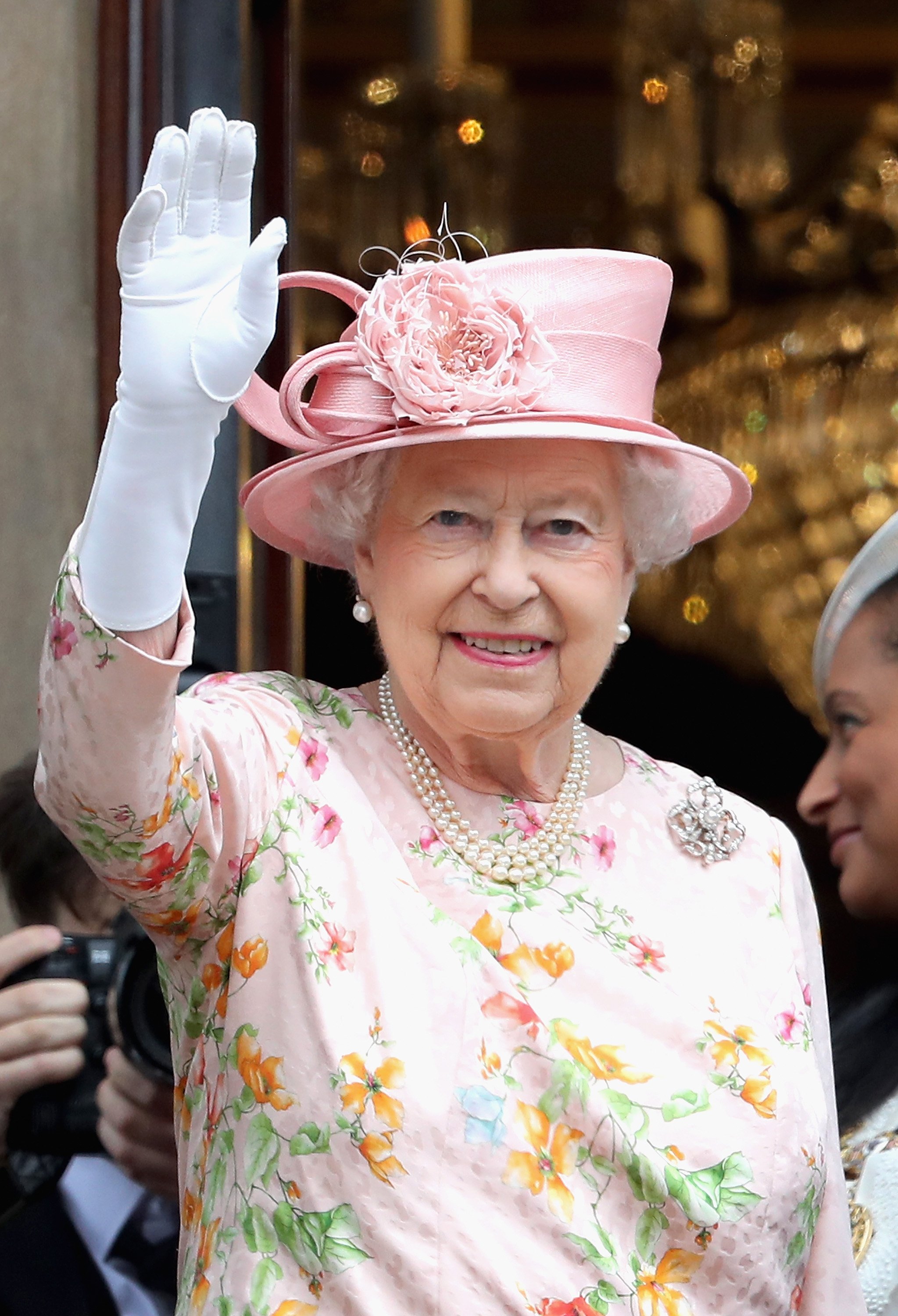
Queen Elizabeth II waves from the balcony of the Town Hall during a visit to Liverpool on June 22, 2016, in Liverpool, England. | Source: Getty Images.
While the tradition is purely symbolic, no money is involved, and the Duke instead pays "rent" by giving the Queen a silk-embroidered French flag, which gets draped over the bust of the first Duke of Wellington in the Guard Chamber at Windsor Castle.
HIGH SHERIFF
The tradition of the reigning monarch picking a ceremonial officer to preside over a British county came from Anglo-Saxon times, however, with it came the peculiar way of appointing a new High Sheriff.
Once the Queen made her pick for the next High Sheriff, she marks the name on a list, with a bodkin or a fancy hemming needle.
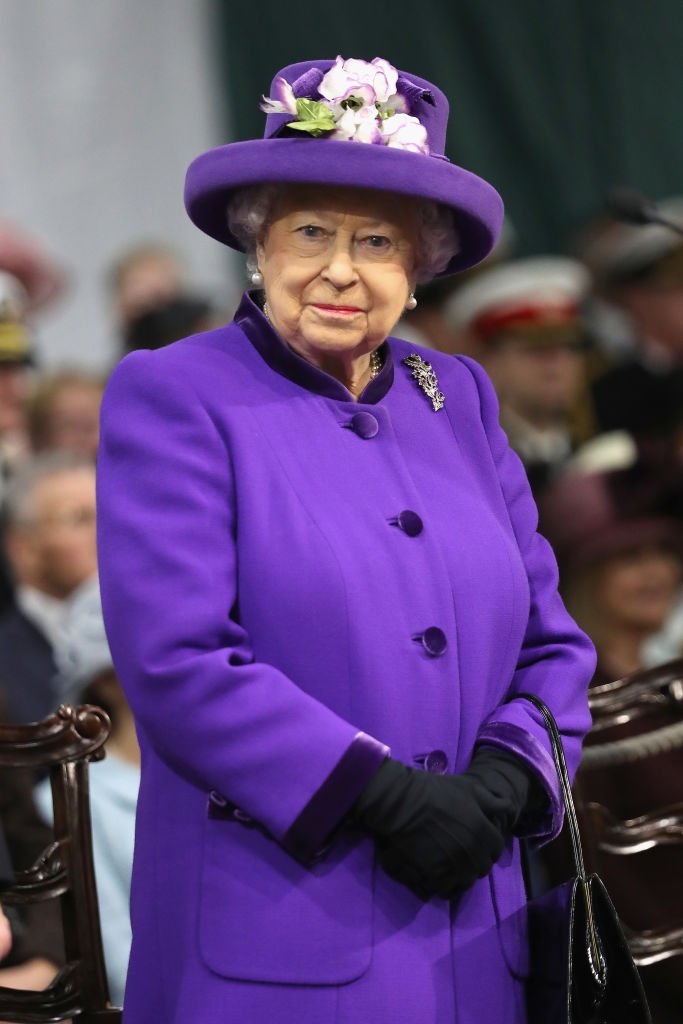
Queen Elizabeth II attends the Commissioning Ceremony of HMS Queen Elizabeth at HM Naval Base on December 7, 2017, in Portsmouth, England. | Source: Getty Images.
While the origin of this tradition is unknown, it has been suggested that Queen Elizabeth I started the unusual tradition by reaching for a bodkin to indicate her choice when asked to make her selection while embroidering.
According to another theory, the sharp bodkin made a permanent mark on the paper which couldn't be tampered with if someone didn't agree with her choices.
SEPARATE TRAVELS
Back in the day when air travel started taking off, it had much more risk to it than it does now. Therefore officials decided to put measures in place to ensure that the royal lineage doesn't get affected if a fatal accident happened while traveling.
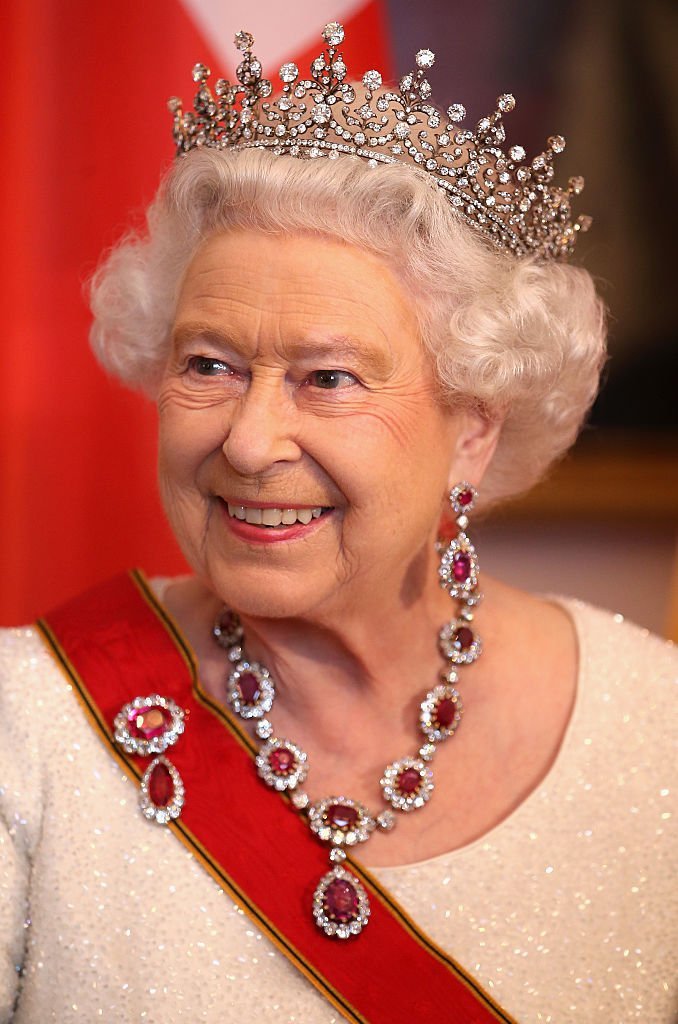
Queen Elizabeth II meets guests during a State Banquet at the Schloss Bellevue Palace on the second day of a four day State Visit on June 24, 2015, in Berlin, Germany. | Source: Getty Images.
Consequently, the King or Queen and their heirs are not allowed to travel on the same plane, even if they are heading to the same destination.
But recent years saw leeway regarding this rule, given that air travel became safer, and the Queen allowed Prince William and Kate Middleton to take Prince George with them on a flight to Australia in 2014.
TEA TIME
A personal tradition of the Queen, she indulges in a cup of tea every day at 5 pm like clockwork no matter where she is.
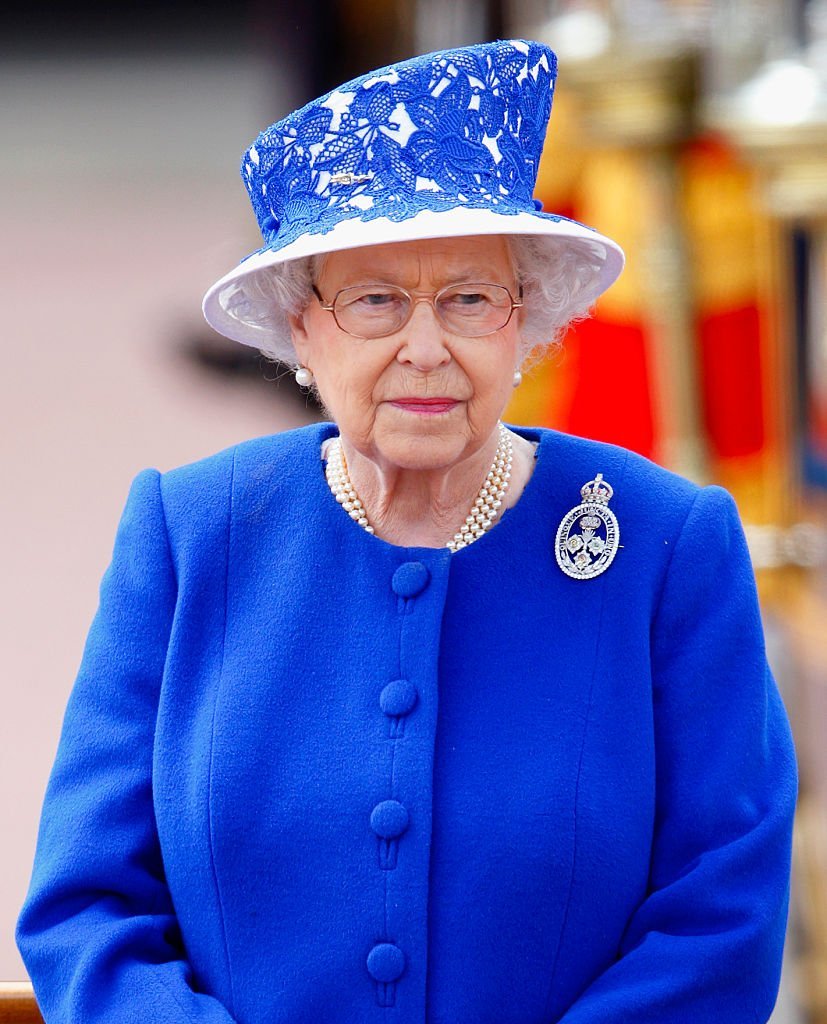
Queen Elizabeth II stands on a dais outside Buckingham Palace during the annual Trooping the Colour Ceremony on June 15, 2013, in London, England. | Source: Getty Images.
When traveling, a kettle, a stash of Dundee cake, and a selection of teas make up some of the essential items while she also rarely eats in public.
Mindful of fellow diners when out on official engagements, the Queen is known to leave a small amount of food on her plate while others finish their meals, as royal protocol insists that everyone stops eating when the Queen finishes her last mouthful.
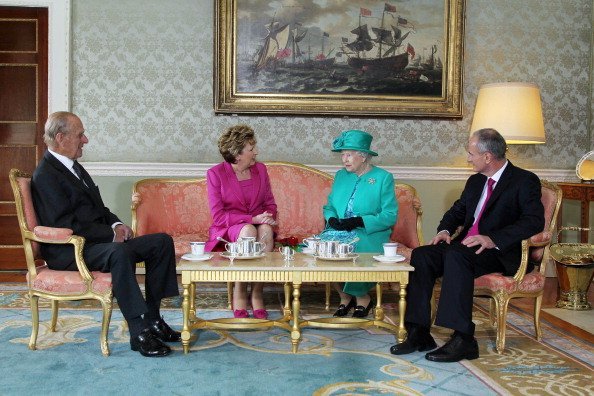
Prince Philip The Duke of Edinburgh, President Mary Mc Aleese, Queen Elizabeth II and Dr Martin Mc Aleese talk over a cup of tea at Aras An Uachtarain on May 17, 2011, in Dublin,Ireland. | Source: Getty Images.
According to an entry on Etiquipedia, guests of Queen Victoria didn't have the same luck as guests of Queen Elizabeth II. Known to be a swift eater, Queen Victoria's guests hardly had time to eat their food since they got served after her, while the last person served often had their plate taken away before taking a bite.
Similarly, the younger generation of royals is under constant scrutiny in the public eye. Judged for their following, or failure to adhere to royal protocol and etiquette never goes by unnoticed, and neither does their habits.
Since Kate Middleton joined the royal ranks, eagle-eyed fans noticed that Kate always carries a clutch purse instead of other types of handbags, and as it turns out, with good reason.
